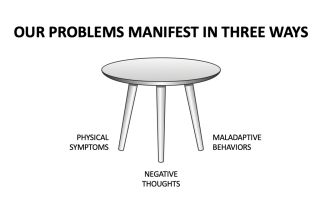Therapy
Problem Solving: Understanding and Dealing with Challenges
The "three-legged-table" schema can help you spot problems.
Updated July 25, 2023 Reviewed by Ray Parker
Key points
- Problems can manifest in three ways: physical symptoms, negative thoughts, and maladaptive behaviours.
- Awareness of how your problems manifest and play out is essential for effective problem-solving.
- By identifying symptoms through the "three-legged table," you can effectively address your problems.

When life is going well, we think positively and we make healthy choices in our day-to-day lives. But when we are overwhelmed, struggling with negative, self-limiting thoughts or maladaptive habits or behaviors, life can seem unmanageable and out of control.
In my work as a clinical psychologist, I use this three-legged table to help my patients find clarity, support, and healing. There are times in our lives when it is critical that we pause, reflect, and try to understand what is going on in our bodies and minds. My three-legged table provides a means of doing just that. It has helped thousands of people understand their problems, and it can help you too. Here’s how it works.
Gaining an awareness of how problems manifest
Every problem we have in life manifests in three possible ways—physical symptoms, negative thoughts (cognitions), and maladaptive, negative behaviors. We can examine how our problems show up and play out in our lives by identifying our physical symptoms, and maladaptive thoughts and behaviors. With these insights and awareness, we can seek the support we need to address what’s happening and start to make positive changes.
A closer look at symptoms
Let’s start with physical symptoms—the first leg of our three-legged table. A number of physical symptoms are triggered by our emotions. Anxiety, for example, is often accompanied by a number of distressing physical symptoms, including headaches, gastrointestinal problems, muscle tension, fatigue, and a racing heart, to name a few. Insomnia, another troubling physical symptom, is also often tied to emotions.
Moving along to the second leg of our table, our problems also manifest as negative, unhealthy thoughts or cognitions. We internalize past hurts and ingrained negative beliefs about how the world works, and our sense of worth in the world.
In low self-esteem, we often develop negative thoughts, which lead to self-depreciation, feelings of hopelessness or worthlessness, and negative thoughts about our abilities, relationships, the world, and opportunities.
Onward to leg number three—maladaptive choices, patterns, and behaviors. Often, we distract or self-soothe with any number of unhealthy, maladaptive behaviors and habits—from eating too much, eating too little, sleeping too much or too little, relying on alcohol and drugs to numb physical symptoms or escape negative thoughts to angry outbursts, self-sabotage, procrastination, self-harm, inflicting or tolerating abuse, mismanaging money, gambling or shopping addictions, staying in a job we dislike, and many more unhealthy behaviors.
Putting the table to use
Whatever is troubling you, put your problem on the top of this three-legged table It can be used for work struggles, low self-esteem, becoming a caregiver to children or elderly parents, relationship troubles, inter-personal conflicts, anger, medical conditions, addictions (like food, alcohol, shopping, and gambling), chronic pain, money concerns, depression, anxiety: anything.
Mired in day-to-day physical symptoms, negative thoughts, and unhealthy patterns, we can feel overwhelmed and helpless. When we are stuck, awareness is the first step to creating positive change.
We can use the three-legged table to gain insight and awareness of the connections between our problems and symptoms, negative thoughts, and maladaptive behaviors. By identifying our symptoms in all three categories (legs), we can begin to address them effectively.
Seeking expert interventions
Most of us are comfortable seeking medical interventions for our physical symptoms, but less aware of what to do about our negative thoughts and maladaptive behaviors. Here, seeking therapy, and working with a mental health professional can be of great assistance in both healing and growth.
Cognitive Behavioural Therapy (CBT), for example, is a solutions-based form of therapy that addresses maladaptive thoughts by challenging and reframing the cognitive distortions and thoughts we hold onto. It also facilitates positive changes by slowly shifting maladaptive behaviors, choices, and habits to healthier, more adaptive ones.
With a deeper understanding and awareness of how problems manifest and play out, we are better able to navigate life’s challenges. We owe it to ourselves to pay attention to our physical and mental health and to create positive change where change is needed.
The first step to positive change—and to addressing our physical symptoms and troublesome thoughts and behaviors—is awareness. With this awareness, we can begin to create positive changes that tackle our problems head-on.
Put your problems on the table
You can work on building awareness when you are struggling or feeling overwhelmed by:
- Listing your troubling physical/physiological symptoms, negative thoughts, and maladaptive behaviors, choices, and patterns
- Thinking about the areas of your life where you would like to create positive change
- Making a commitment to yourself to reach out and find the supports you need to address your physical symptoms, negative thoughts, and behaviors
- Bringing in the resources you need to address problematic thoughts and behaviors and address your physical symptoms
To find a therapist, please visit the Psychology Today Therapy Directory.




